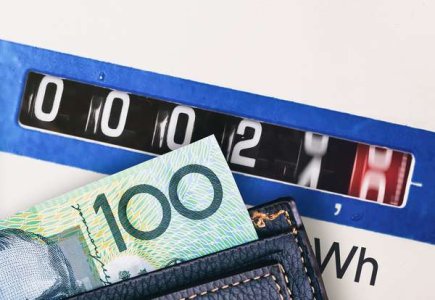Powering up: Experts sound warning as Australian power prices stay shockingly high!
- Replies 13
Australians are no strangers to the ever-fluctuating costs of living, and one of the most significant household expenses they grapple with is the electricity bill.
It's a topic that hits close to home for many, especially for those who need to budget carefully.
The recent news from experts about power prices is, therefore, something we all need to pay attention to.
Craig Souter, a single father from Worrigee in Shoalhaven, New South Wales, is one such individual who keeps a vigilant eye on his power costs.
With a mortgage and all the household bills to pay, every dollar counts for him.
‘You're always on the lookout for the best deal,’ he said. ‘And I'll always compare. I'm not loyal… I'm happy to change.’
‘Because I had two boys living at home. We had a pool going, we had tablets on all the time, phones, internet, washing, and long showers by teenage boys, and all those sorts of things,’ he added.

Despite his efforts to find the best deals and his willingness to switch providers, Mr Souter was hit with a severe case of bill shock when his power bill more than doubled from $600 to over $1,400.
This staggering increase came after his supplier, Origin Energy, installed a smart meter at his house.
‘It's a hit, you know, because I earn okay money, but I'd be only earning as much as everybody else,’ Mr Souter remarked.
‘I pay my own mortgage on my own. I pay all my own bills here, like electricity, insurance… everything.’
‘This is my place and I'm paying, so it's a killer,’ he lamented.
A spokesperson from Origin Energy attributed the rise to increased usage, an underestimation of a previous invoice, and a switch to a more expensive plan.
Unfortunately, Mr Souter’s story is not unique in today's electricity market, where prices have surged since the energy crisis two years ago.
The Australian Energy Regulator (AER) and its Victorian counterpart, the Essential Services Commission, set benchmark prices known as default market offers, which act as a cap on what retailers can charge.
While only about 10 per cent of residential customers are on these default offers, they serve as a reference point for other plans.
After a 40 per cent increase in the past two years, there was hope that recent drops in the spot market might bring some relief to consumers.
Certain analysts proposed that prices might decrease by significant ‘double-digit’ percentages.
However, as regulatory bodies prepare to unveil draft determinations for the new benchmark prices, experts expressed uncertainty regarding the outcome.
Josh Stabler, Managing Director at advisory firm Energy Edge, cautioned, ‘I would say that we're going to be plus or minus a few per cent here in terms of the pricing.’
‘This is, despite some rhetoric regarding lower prices in the spot market. I just don't see that passing through to the final calculation on the DMO (Default Market Offer).’
‘Now, this is all just based on the data that we can see in the market. The (AER) will do its own analysis independently, in its own process, and may come to its own conclusions,’ he added.
As per Mr Stabler, although wholesale electricity expenses have decreased from their peak levels, they still remain relatively high.
Additionally, he noted that escalating interest rates and inflation are driving up network expenses—specifically, the costs associated with poles and wires—which typically constitute the largest portion of an electricity bill.
Mr Stabler also highlighted that regulators must take into account projected future wholesale electricity prices when establishing benchmark tariffs for the upcoming year.
He emphasised that these anticipated future wholesale costs, also known as forward wholesale prices, are not anticipated to significantly decrease.
‘Now, when we take a look at what's happened in the last 10, 12 months, the conditions for 2024-25 are generally the same as what they thought in May 2023 for the previous financial year,’ he said.
‘The market conditions for the new financial year aren't substantially different.’
‘They might be 5 per cent below or about even. It's not 20 per cent below, but it's not 20 per cent above,’ he added.
AER Director Justin Oliver shared a similar sentiment, indicating that while the energy crisis of 2022 is mostly behind us, its effects are still lingering.
‘Broadly speaking, we're not anticipating huge movements in either direction,’ Mr Oliver said.
‘It may go up or down depending on where people live.’
‘We're not expecting big increases but we're not necessarily expecting big decreases either at this stage,’ he added.
Jacqueline Crawshaw, Policy Director of Energy Consumers Australia, advised that, regardless of regulatory decisions, the best course of action for consumers is to shop around for the most competitive rates.
‘We're hearing some stories about some of the challenges in the market,’ she acknowledged.
‘But we're also hearing some good stories as well in terms of the wholesale price, which seems to be easing a bit lately. So, we're hopeful that what we'll see is not as bad an outcome as what we've seen over the past couple of years.’
‘The last couple of years we've seen increases of 20 per cent, and that's unsustainable for consumers,’ she added.
For Souter, who is looking towards retirement in six years, the prospect of continuing high electricity costs is daunting.
‘So, if I'm going to be paying that sort of money, that's over $5,000 a year just in electricity. How do you survive? How does anyone survive?’ he asked.
Regardless of the outcome of these changes, you can save money on your energy bills by focusing on things you can control.
First, you have to identify the most contributing factors to your energy bills to adjust accordingly, then you can check out these tips on saving energy and money.
 Have you noticed any changes in your energy bills? What are your tips on how to save big on your monthly bill? Let us know in the comments below!
Have you noticed any changes in your energy bills? What are your tips on how to save big on your monthly bill? Let us know in the comments below!
It's a topic that hits close to home for many, especially for those who need to budget carefully.
The recent news from experts about power prices is, therefore, something we all need to pay attention to.
Craig Souter, a single father from Worrigee in Shoalhaven, New South Wales, is one such individual who keeps a vigilant eye on his power costs.
With a mortgage and all the household bills to pay, every dollar counts for him.
‘You're always on the lookout for the best deal,’ he said. ‘And I'll always compare. I'm not loyal… I'm happy to change.’
‘Because I had two boys living at home. We had a pool going, we had tablets on all the time, phones, internet, washing, and long showers by teenage boys, and all those sorts of things,’ he added.

Despite analysts anticipating a decline in prices, some experts warned that electricity expenses are unlikely to decrease substantially. Credits: Shutterstock
Despite his efforts to find the best deals and his willingness to switch providers, Mr Souter was hit with a severe case of bill shock when his power bill more than doubled from $600 to over $1,400.
This staggering increase came after his supplier, Origin Energy, installed a smart meter at his house.
‘It's a hit, you know, because I earn okay money, but I'd be only earning as much as everybody else,’ Mr Souter remarked.
‘I pay my own mortgage on my own. I pay all my own bills here, like electricity, insurance… everything.’
‘This is my place and I'm paying, so it's a killer,’ he lamented.
A spokesperson from Origin Energy attributed the rise to increased usage, an underestimation of a previous invoice, and a switch to a more expensive plan.
Unfortunately, Mr Souter’s story is not unique in today's electricity market, where prices have surged since the energy crisis two years ago.
The Australian Energy Regulator (AER) and its Victorian counterpart, the Essential Services Commission, set benchmark prices known as default market offers, which act as a cap on what retailers can charge.
While only about 10 per cent of residential customers are on these default offers, they serve as a reference point for other plans.
After a 40 per cent increase in the past two years, there was hope that recent drops in the spot market might bring some relief to consumers.
Certain analysts proposed that prices might decrease by significant ‘double-digit’ percentages.
However, as regulatory bodies prepare to unveil draft determinations for the new benchmark prices, experts expressed uncertainty regarding the outcome.
Josh Stabler, Managing Director at advisory firm Energy Edge, cautioned, ‘I would say that we're going to be plus or minus a few per cent here in terms of the pricing.’
‘This is, despite some rhetoric regarding lower prices in the spot market. I just don't see that passing through to the final calculation on the DMO (Default Market Offer).’
‘Now, this is all just based on the data that we can see in the market. The (AER) will do its own analysis independently, in its own process, and may come to its own conclusions,’ he added.
As per Mr Stabler, although wholesale electricity expenses have decreased from their peak levels, they still remain relatively high.
Additionally, he noted that escalating interest rates and inflation are driving up network expenses—specifically, the costs associated with poles and wires—which typically constitute the largest portion of an electricity bill.
Mr Stabler also highlighted that regulators must take into account projected future wholesale electricity prices when establishing benchmark tariffs for the upcoming year.
He emphasised that these anticipated future wholesale costs, also known as forward wholesale prices, are not anticipated to significantly decrease.
‘Now, when we take a look at what's happened in the last 10, 12 months, the conditions for 2024-25 are generally the same as what they thought in May 2023 for the previous financial year,’ he said.
‘The market conditions for the new financial year aren't substantially different.’
‘They might be 5 per cent below or about even. It's not 20 per cent below, but it's not 20 per cent above,’ he added.
AER Director Justin Oliver shared a similar sentiment, indicating that while the energy crisis of 2022 is mostly behind us, its effects are still lingering.
‘Broadly speaking, we're not anticipating huge movements in either direction,’ Mr Oliver said.
‘It may go up or down depending on where people live.’
‘We're not expecting big increases but we're not necessarily expecting big decreases either at this stage,’ he added.
Jacqueline Crawshaw, Policy Director of Energy Consumers Australia, advised that, regardless of regulatory decisions, the best course of action for consumers is to shop around for the most competitive rates.
‘We're hearing some stories about some of the challenges in the market,’ she acknowledged.
‘But we're also hearing some good stories as well in terms of the wholesale price, which seems to be easing a bit lately. So, we're hopeful that what we'll see is not as bad an outcome as what we've seen over the past couple of years.’
‘The last couple of years we've seen increases of 20 per cent, and that's unsustainable for consumers,’ she added.
For Souter, who is looking towards retirement in six years, the prospect of continuing high electricity costs is daunting.
‘So, if I'm going to be paying that sort of money, that's over $5,000 a year just in electricity. How do you survive? How does anyone survive?’ he asked.
Regardless of the outcome of these changes, you can save money on your energy bills by focusing on things you can control.
First, you have to identify the most contributing factors to your energy bills to adjust accordingly, then you can check out these tips on saving energy and money.
Key Takeaways
- Craig Souter, a resident of Shoalhaven on the south coast of New South Wales, experienced a more than doubling of his usual power bill, causing significant financial distress.
- Despite some analysts' expectations of falling prices, experts warned that electricity costs are unlikely to decrease substantially due to various market factors.
- The Australian Energy Regulator and the Essential Services Commission are preparing to set new benchmark prices, which will not likely offer significant relief to consumers.
- While the worst price rises might be over, Energy Consumers Australia advised consumers to shop around for the best power deals, as challenges in the energy market persist.







